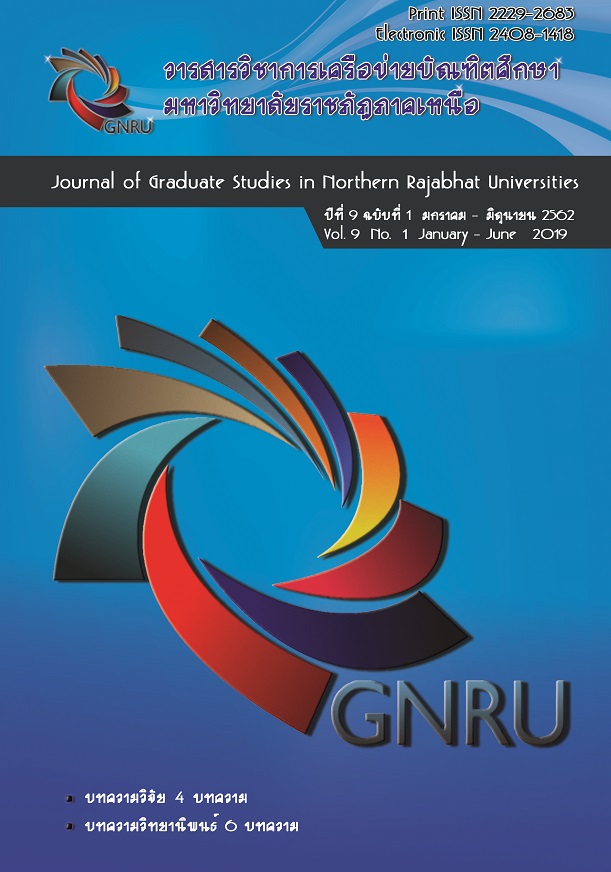การวิเคราะห์องค์ประกอบเชิงยืนยันของความสามารถในการแข่งขันของธุรกิจการค้าข้ามแดนจังหวัดเชียงราย Confirmatory Factor Analysis of Competitiveness of Chiang Rai’s Trans-Border Business
Main Article Content
Abstract
งานวิจัยนี้มีจุดมุ่งหมายเพื่อศึกษาความสามารถในการแข่งขันของธุรกิจการค้าข้ามแดนจังหวัดเชียงราย และวิเคราะห์องค์ประกอบเชิงยืนยันของความสามารถในการแข่งขันของธุรกิจการค้าข้ามแดนจังหวัดเชียงราย รวมทั้งตรวจสอบความสอดคล้องของระหว่างโครงสร้างองค์ประกอบความสามารถในการแข่งขันของธุรกิจการค้าข้ามแดนจังหวัดเชียงราย กับข้อมูลเชิงประจักษ์ โดยมีกลุ่มตัวอย่าง คือ ผู้บริหารของสถานประกอบการการค้าข้ามแดน-การค้าชายแดน จากจังหวัดเชียงราย จำนวน 295 แห่ง ใช้แบบสอบถามเป็นเครื่องมือที่ใช้ในการรวบรวมข้อมูล ด้วยวิธีการสุ่มตัวอย่างแบบแบ่งชั้น โดยใช้ต้นทางการส่งออกจากด่านศุลการกรเป็นหลักในการแบ่งชั้น และสุ่มข้อมูลอย่างเป็นระบบ จำแนกตามแหล่งที่ตั้งของสถานประกอบการโดยใช้ตารางเลขสุ่ม ตรวจสอบความเที่ยงตรง ด้วยค่าดัชนีความสอดคล้อง (IOC) ได้ค่าดัชนีในภาพรวม 0.86 ตรวจสอบความเชื่อถือได้ด้วยค่าสัมประสิทธิ์อัลฟ่าของครอนบาคได้ 0.931 วิเคราะห์ข้อมูลด้วยสถิติเชิงพรรณนา และการวิเคราะห์องค์ประกอบเชิงยืนยัน ผลการวิจัยพบว่า ความสามารถในการแข่งขันของธุรกิจการค้าข้ามแดนจังหวัดเชียงรายอยู่ในระดับค่อนข้างมาก โดยมีค่าเฉลี่ยในภาพรวมเท่ากับ 4.16 โดยองค์ประกอบของความสามารถในการแข่งขันของธุรกิจการค้าข้ามแดนจังหวัดเชียงราย มี 4 องค์ประกอบคือ องค์ประกอบด้านการเงิน องค์ประกอบด้านการตลาด องค์ประกอบด้านการดำเนินงาน และองค์ประกอบด้านอื่น ๆ ผลการวิเคราะห์องค์ประกอบเชิงยืนยันลำดับสองพบว่าโมเดลมีความสอดคล้องกับข้อมูลเชิงประจักษ์ โดยมีค่า Chi-Square เท่ากับ 104.518, d.f. เท่ากับ 85 ซึ่งจะได้ค่า c2/d.f. เท่ากับ 1.230 ค่า p-value เท่ากับ 0.074 ค่าดัชนี GFI เท่ากับ 0.957 ค่าดัชนี AGFI เท่ากับ 0.931 ค่าดัชนี RMSEA เท่ากับ 0.028 ค่าดัชนี CFI เท่ากับ 0.994 ค่าดัชนี HOELTER เท่ากับ 303.000 และค่าดัชนี TLI เท่ากับ 0.991
This study aimed to study Chiang Rai’s trans-border business competitiveness, analyze confirmatory factors of Chiang Rai’s trans-border business competitiveness, and validate the consistency of Chiang Rai’s trans-border business competitiveness model and empirical data. The samples were 295 of administrators of Chiang Rai’s trans-border businesses. The data were collected by questionnaires with a stratified random sampling technique which divided into stratum by exporting customs, then the systematic randomness was applied on location of business to randomized by the random number table. The Cronbach’s Alpha Coefficient is 0.931 was checked for reliability and the Index of Item – Objective Congruence (IOC) of overall is 0.89 was checked for validity. The data were analyzed by descriptive statistics and confirmatory factor analysis. The results were as follows: Chiang Rai’s trans-border business competitiveness was in rather high level, there are 4 factors of the competitiveness those are; Financial factor, Marketing factor, Operation factor and other factors. Finally, the result of second order confirmatory analysis found that the competitiveness model was consistent with the empirical data which verified by index values those are; Chi-Square is 104.518, d.f. is 85, c2/d.f. is 1.230, p-value is 0.074, GFI is 0.957, AGFI is 0.931, RMSEA is 0.028, CFI is 0.994, HOELTER index is 303.000 and TLI is 0.991.
Article Details
References
คณะกรรมการบริหารงานจังหวัดแบบบูรณาการจังหวัดเชียงราย. (2559). แผนพัฒนาจังหวัดเชียงราย พ.ศ. 2560-2564 (ฉบับทบทวน).สำนักงานจังหวัดเชียงราย ศาลากลางจังหวัดเชียงราย, เชียงราย.
ณัฐพรพรรณ อุตมา, สิทธิชาติ สมตา และพรพินันท์ ยี่รงค์. (2558). OBEL Outlooks 2015 พลวัตทางสิ่งแวดล้อมเศรษฐสังคมชายแดน. ภาพรวมเศรษฐกิจชายแดนและโลจิสติกส์, เชียงราย: มหาวิทยาลัยแม่ฟ้าหลวง.
ดนัย บวรเกียรติกุล, วัลลภ ใจดี และพูลพงศ์ สุขสว่าง. (2561). การสร้างข้อเสนอแนะการดำเนินการมีส่วนร่วมของประชาชนในการชดเชยผลกระทบสิ่งแวดล้อมในแหล่งท่องเที่ยวจากกรณีน้ำมันดิบรั่วไหลที่เกาะเสม็ดเพื่อสร้างเป็นรูปแบบสมการโครงสร้าง (SEM) และทดสอบด้วยโปรแกรมทางสถิติลิสเรล. วารสารวิชาการและวิจัยสังคมศาสตร์, 13(37), 31-46.
ธิติยา ทองเกิน. (2561). การมีส่วนร่วมของชุมชนในการวางแผนกลยุทธ์ทางการตลาดเพื่อส่งเสริมการดำเนินงานของกลุ่มนวดเพื่อสุขภาพ กรณีศึกษา กลุ่มนวดเพื่อสุขภาพวัดคลองคาง จังหวัดนครสวรรค์. วารสารวิชาการเครือข่ายบัณฑิตศึกษามหาวิทยาลัยราชภัฏภาคเหนือ, 8(14), 41-56.
นิยม ไวยรัชพานิช. (2550). เอกสารคำบรรยายการค้าชายแดน. กรุงเทพฯ: สภาหอการค้าแห่งประเทศไทย.
ปฏิมา พิมพ์สกุล, สุเทพ นิ่มสาย. (2558). การคาดการณ์ผลกระทบจากนโยบายประชาคมเศรษฐกิจอาเซียนต่ออุตสาหกรรมการค้าและการท่องเที่ยวในเขตเมืองชายแดนจังหวัดเชียงราย. วารสารวิทยาการจัดการ, 10(2), 15-42.
ศุภมาส อังศุโชติ, สมถวิล วิจิตรวรรณา, และรัชนีกูล ภิญโญภานุวัฒน์. (2552). สถิติวิเคราะห์สำหรับการวิจัยทางสังคมศาสตร์และพฤติกรรมศาสตร์: เทคนิคการใช้โปรแกรม LISREL. กรุงเทพฯ: เจริญดีมั่งคงการพิมพ์.
ศูนย์เทคโนโลยีสารสนเทศและการสื่อสาร สำนักงานปลัดกระทรวงพาณิชย์ โดยความร่วมมือจากกรมศุลกากร. (2561). สถิติการค้าชายแดนและการค้าผ่านแดนของไทย. สืบค้นเมื่อ 16 กุมภาพันธ์ 2651, จาก http://btsstat.dft.go.th.
สำนักงานคณะกรรมการพัฒนาการเศรษฐกิจและสังคมแห่งชาติ. (2555) แผนพัฒนาเศรษฐกิจและสังคมแห่งชาติ ฉบับที่สิบเอ็ด พ.ศ. ๒๕๕๕ - ๒๕๕๙. กรุงเทพฯ:สำนักนายกรัฐมนตรี.
อดิเรก ฟันเขียว. (2558). การยอมรับ ความคาดหวังและปัจจัยความสาเร็จในการพัฒนาเขตเศรษฐกิจ พิเศษชายแดน ในจังหวัดตาก. วารสารวิชาการเครือข่ายบัณฑิตศึกษามหาวิทยาลัยราชภัฏภาคเหนือ, 4(6), 1-14.
Barney B. Jay. (2001). Resource-based theories of competitive advantage: A ten-year retrospective on the resource-based view. Journal of Management. 27 (6), 643-650.
Bharadwaj G. Sundar, Varadarajan P. Rajan and Fahy John. (1993). Sustainable Competitive Advantage in Service Industries: A Conceptual Model and Research Propositions. Journal of Marketing, 57 (4), 83-99.
Castanias P. Richard, Helfat E. Constance. (2001). The managerial rents model: Theory and empirical analysis. Journal of Management, 27(6), 661-678.
Cockburn, John., Siggel, Eckhard, Coulibaly, Massaoly, Vezina, Sylvain. (1998). Measuring Competitiveness and Its Sources: The Case of Mali's Manufacturing Sector. (Research Report). Agency for International Development, Bureau for Africa, Office of Sustainable Development. Washington, D.C., United States.
Cooper N. Richard. (2005). The political economy of competitiveness. Retrieved October 22, 2017, from http://www.nesdb.go.th/article_attach/01-RNCooper.pdf
Dess G. Gregory & Robinson Jr. B. Richard. (1984). Measuring Organizational Performance in the Absence of Objective Measures: The Case of the Privately-Held Firm and Conglomerate Business Unit. Strategic Management Journal, 5 (3), 265 – 273.
Doyle, Peter and Wong, Veronica. (1998). Marketing and competitive performance: an empirical study. European Journal of Marketing , 32 (5/6), 514-535.
Ellinger, Alexandeer E., Patricia J. Daugherty, and Craig M. Gustin. (1997). The relationship between integrated logistics and customer service. Transportation Research Part E: Logistics and Transportation Review, 33(2), 129-138.
Field, A. (2000). Discovering statistics using spss for windows. London-Thousand Oaks- New Delhi: Sage publications.
Forsman, S. (2001). Resource-based strategy analysis: A case of local food processing firms in Finland. The Food Sector in Transition-Nordic Research, 313 (3), 51-62.
George, D., & Mallery, M. (2010). SPSS for Windows Step by Step: A Simple Guide and Reference, 17.0 update (10th ed.) Boston: Pearson.
Gravetter, F., & Wallnau, L. (2014). Essentials of statistics for the behavioral sciences. (8th ed.) Belmont, CA: Wadsworth.
Hair, J. F., Anderson, R. E., Tatham, R. L., & Black, W. C. (2006). Multivariate Data Analysis. (6th ed.) : Pearson Prentice Hall. Upper Saddle River, N.J.
International Institute for Management Development. (2003). IMD world competitiveness yearbook 2003. Retrieved October 25, 2017, from https://www.imd.org/wcc/world-competitiveness-center/.
Kumsuprom, S. (2010). Structured approach to organisational ICT risk management: An empirical study in Thai businesses. Doctor of Philosophy. RMIT University. Melbourne, Australia.
McDougall P. Patricia & Oviatt M. Benjamin. (1996). New venture internationalization, strategic change, and performance: A follow-up study. Journal of Business Venturing, 11 (1), 23-40.
Morgan A. Neil, Vorhies W. Douglas & Schlegelmilch B. Bodo B. (2006). Resource–performance relationships in industrial export ventures: The role of resource inimitability and substitutability. Industrial Marketing Management, 35(5), 621-633.
National Competitiveness Council. (2012). Annual competitiveness report 2012. Retrieved October 22, 2017, from http://www.forfas.ie/ncc/reports/ncc/ann1.htm.
Ondategui-Parra, S., Bhagwat, J. G., Zou, K. H., Gogate, A., Intriere, L. A., Kelly, P., & Ros, P. R. (2004). Practice management performance indicators in academic radiology departments. Radiology, 233 (3), 716-722.
Trochim, W. M., & Donnelly, J. P. (2006). The research methods knowledge base (3rd ed.). Cincinnati, OH:Atomic Dog.
Zou, Shaoming, Charles R. Taylor, and Gregory E. Osland. (1998). The EXPERF Scale: A Cross-National Generalized Export Performance Measure. Journal of International Marketing, 6 (3), 37-58.


